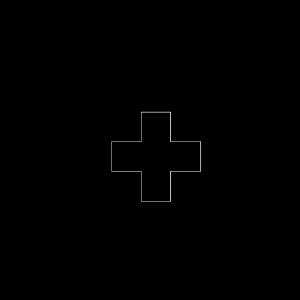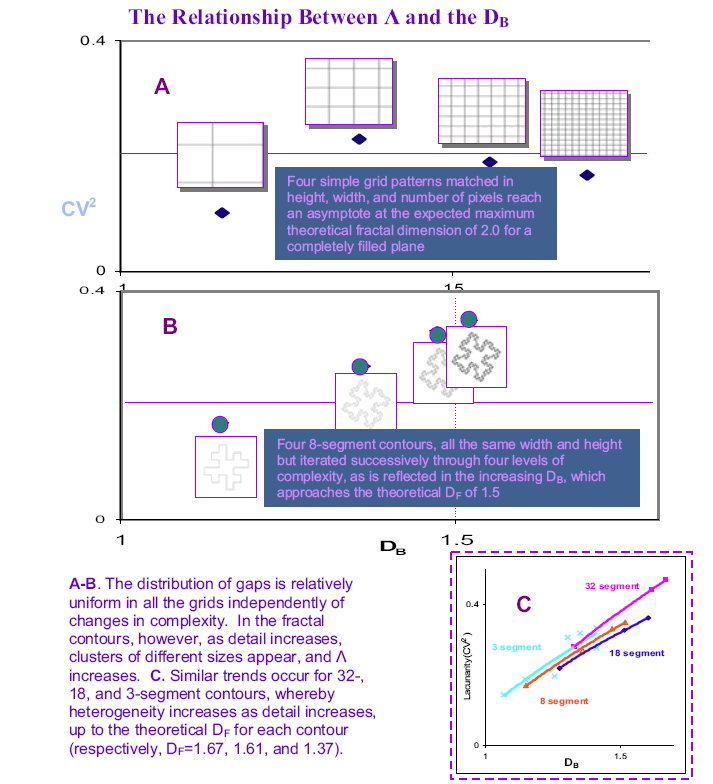Scaling
Before reading further, observe limited scaling in a digital image of a fractal by:
- Clicking on the black on white Fractal Cross you see below to activate it.(The image was generated with the Fractal Generator plugin)
- Right clicking on the very top and selecting "Zoom In".
- Repeatedly clicking the same place to zoom in further and further.
- Enjoying watching how the basic pattern is scaled and repeated.
Limits of Resolution
If you zoomed to where there is no more scaling above, you saw illustrated a practical issue for digital images.
Because it is of finite size, a digital image has a lower limit of representation - the limit of the computer screen (i.e., a pixel). This page discusses a limitation in scaling of digitally generated fractal images imposed by the finite nature of a computer screen.
The previous section discussed other limitations related to digitization of fractal patterns.
Size vs Resolution for Fractal Images
Although real fractals scale infinitely, fractal patterns made as digital images trade detail for scale. For 32-segment quadric fractals made with the Fractal Generator plugin, for instance, each time a pattern is iterated, the new "parts" comprising the detail are scaled by 1/8. Thus, if the pattern starts with "pieces" that are 8 pixels long, on the first iteration the new parts will be 1 pixel long. In digital imaging, successive scalings soon near 1 unit, which means that if a pattern is iterated several times, its digital image may have to be made large to maintain resolution at the finest level.
The original length for a pattern that is required to keep the smallest represented part at least 1 pixel long can be determined from the number of iterations and the scaling rule. At each iteration (η), a figure is scaled by a factor (ρ), to give a new size for the parts, δ. Starting from the distance between two points defining its initial length (Δ), the length of a part at η can be found from; δη = Δ(ρη) Letting δη=1 pixel and solving gives the initial length: Δ = ρ-η
For the cross fractal you zoomed in on above, there are 3 1/3 new parts, each scaled by ρ=(√5)-1 (DF = log 3.33/log √5 = 1.49). The starting length that will give 1-pixel long parts at 3 iterations = δη = 3 = ρ-η = (√5)3 = 11.2, so a starting size of about 11 pixels will maintain resolution at the finest level. Iterating some fractal patterns very many times while trying to maintain a lower limit of resolution at 1 pixel can, however, generate very large images. The number of parts at 8 iterations, for instance, is (√5)8=625, so a starting size of 625 pixels will maintain resolution at the finest level, but produce an image 8,151 pixels wide. The quadric cross fractal image zoomed in on above was generated using a final resolution of one pixel at its finest level of detail for 8 iterations of scaling, and the original file when analyzed has a calculated fractal dimension of 1.48, very close to theoretical (1.49) ( right click here to download the original image file so you can analyze it with FracLac). But it is too large to view in a browser, and had to be digitally scaled to illustrate the fractal pattern and its practical limits. To further illustrate the importance of this, for the 32-segment quadric fractal with 32 new parts scaled by a factor of 8 at each iteration, the length at which 1 pixel resolution will be maintained is 88=16,777,216, which is prohibitively large for digital imaging today.
Number of Iterations and the DB
 Another point to be aware
of
when using fractal images is that the number of
times a pattern is iterated affects the measured
fractal dimension. The iteration process is shown
in the animated gif of the quadric cross
.
If the gif is not currently animating, reload
the page and it will loop through a sequence of
images showing from 1 to 5 iterations of the fractal
pattern scaling into 3 1/3 new parts at a scale
of 1/√5 every time. The lowest level is not
very complex; it is essentially a plain contour,
with a fractal dimension of 1.00. The second level
is more complex, but the calculated DB
is still low. The general trend is illustrated below,
which shows both the DB and
lacunarity, illustrating
that for iterated fractal images,
the DB
rises and nears theoretical as the number of iterations
increases.
Another point to be aware
of
when using fractal images is that the number of
times a pattern is iterated affects the measured
fractal dimension. The iteration process is shown
in the animated gif of the quadric cross
.
If the gif is not currently animating, reload
the page and it will loop through a sequence of
images showing from 1 to 5 iterations of the fractal
pattern scaling into 3 1/3 new parts at a scale
of 1/√5 every time. The lowest level is not
very complex; it is essentially a plain contour,
with a fractal dimension of 1.00. The second level
is more complex, but the calculated DB
is still low. The general trend is illustrated below,
which shows both the DB and
lacunarity, illustrating
that for iterated fractal images,
the DB
rises and nears theoretical as the number of iterations
increases.